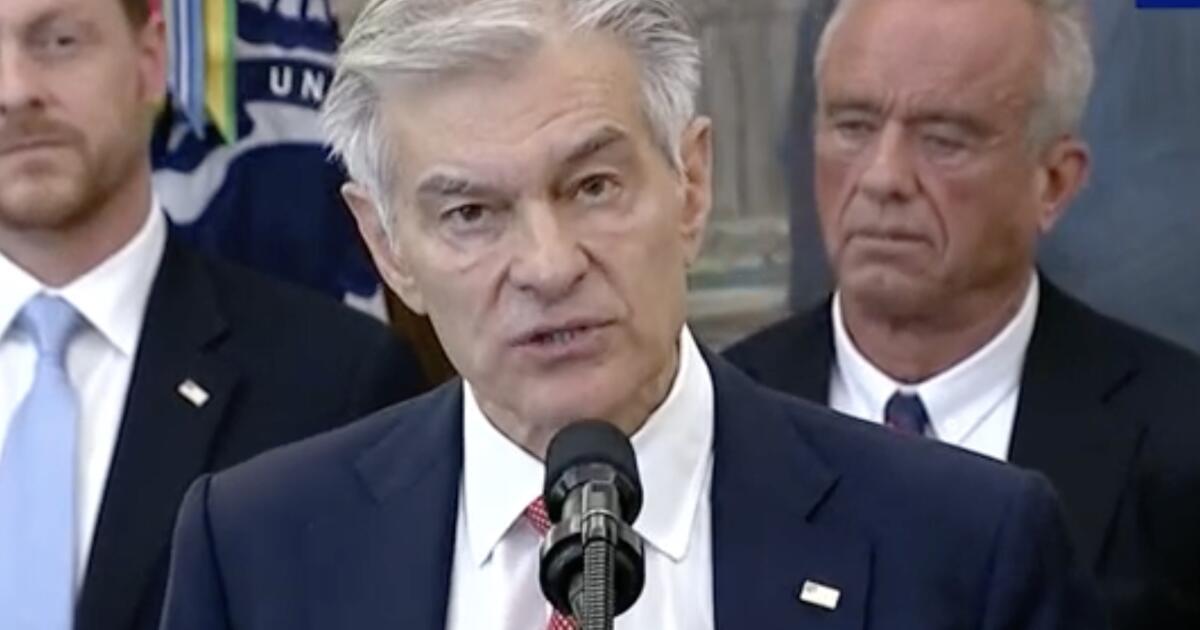Hiltzik: How Trump’s math doesn’t add up
At a White House event on Nov. 6 announcing price cuts for those blockbuster weight-loss drugs, Medicare and Medicaid Administrator Mehmet Oz made an astonishing claim.
Because the price cuts would vastly improve access to the prescription drugs, Oz said, by next year’s midterm elections in November, “Americans will lose 135 billion pounds.”
As though to make sure nobody missed the magnitude of the achievement, Oz hit the word “billion” with all its plosive force: “135 BILLION pounds.”
Well, that would be some achievement. The U.S. population is just over 340 million. Do the math, and Oz’s figure works out to an average weight loss of 347 pounds for every man, woman and child in America.
Homeowners are not building much wealth with a 50-year mortgage.
— Economist Dean Baker
Oz called the calculation “our estimate based on company numbers,” referring to Lilly and Novo Nordisk, the makers of the most popular drugs in the category. His figure was a vast improvement over what he said was his agency’s original estimate of 125 million pounds.
Perhaps Oz just misspoke; it’s certainly not uncommon for people to substitute “billions” for “millions” in quotidian speech. (More on that shortly.) But his casual retailing of obviously bogus arithmetic points to a broader issue with the numbers the Trump White House routinely injects into its policy statements.
The administration’s suspect arithmetic is in many respects deliberately aimed at portraying some condition as better than the real numbers show.
It’s also reliant, however, on people’s proverbial dislike, even fear, of math — whether we’re talking about calculating the tip at a restaurant or the statistical risk of dying from a lightning strike or in a terrorist attack. The mathematician John Allen Poulos described this phenomenon as “innumeracy,” the title of his classic 1989 book on the topic.
As is the case in all hierarchical organizations, the problem starts at the top. President Trump loves to define his ostensible political achievements and goals with big numbers. For example, he claimed in August to have cut prescription drug prices “by 1,200, 1,300 and 1,400, 1,500%.”
To an unwary listener, that sounds like another major achievement. In mathematical terms, though, it’s impossible: A 1,500% reduction would mean reducing a $100 drug bill to negative $1,400, meaning that the drug company would be paying you to use its product.
In recent weeks, Trumpian innumeracy has cropped up in official dispatches not only in relation to healthcare, but also home mortgages and (especially) inflation. The partisan value of mathematical deception is manifest. But it’s also dangerous.
“One rarely discussed consequence of innumeracy is its link with pseudoscience,” Poulos wrote. That’s at the core of the anti-vaccine movement and the doubts sown by partisan actors in the science of COVID-19‘s origins — specifically, the evidence-free assertions that the virus was concocted in a Chinese laboratory.
Let’s examine the most recent displays of bogus math from the Trump administration.
Healthcare math: Oz employed his weight-loss conjecture to dress up the effect of Trump’s price negotiations with Lilly and Novo Nordisk. The figure he offered as the administration’s initial estimate of 125 million pounds lost by next November’s election was not especially impressive, as it implied an average loss of about one-third of a pound per capita.
If we adjust these stats to cover the 12% of American adults who have taken the drugs — about 3.12 million users — that’s a loss of 40 pounds per user, which is at the very high end of per-user weight loss experiences. A 2023 study found that about one-third of users lost more than 5% of their body weight after about 18 months; for a 250-pound user, that’s a loss of about 12.5 pounds in a year and a half.
I asked the Department of Health and Human Services, Oz’s parent agency, to clarify his statement but didn’t receive a reply. I also asked Novo Nordisk and Lilly what “company numbers” he might have been referring to. Lilly didn’t reply, and Novo Nordisk emailed me to say it had nothing to say on the matter.
Mortgage math: As an ostensible solution to the diminishing affordability of home ownership, the administration advanced the idea of giving homebuyers the option of 50-year mortgages. That’s a big departure from the standard 30-year, fixed-rate home loan, the most popular option.
Trump endorsed this fundamentally unserviceable idea with a Truth Social post in which he depicted himself as Franklin D. Roosevelt’s equal as a “great American President” — indeed, as going one better than FDR, to whom he attributed the introduction of the 30-year mortgage.
(Actually, under FDR the standard mortgage, a three-to-five-year loan with interest-only payments ending in a balloon payment and required refinancing, gave way to fully amortized loans that would be paid off in 15 years; the 30-year mortgage didn’t become the standard until the 1950s.)
What makes the 50-year mortgage such a chuckleheaded product? Let’s do the math.
Here’s a nugget of truth about it: The monthly payment on the same size mortgage at the same rate would be lower on a 50-year term than on a 30-year term. On a $400,000 loan at 6%, the interest and principal payment would be $2,106 for the former versus $2,398 on the latter, an apparent savings of $292 a month. For borrowers living on the edge, that’s a sizable difference.
Here are the catches, however. First, over the life of the loan, borrowers will pay much more in interest for the longer loan — in our examples, the total in interest on the 50-year loan comes to about $650,000, versus $461,000 over 30 years.
Moreover, it’s almost certain that lenders will charge a higher rate for the longer-term loan. No one is quite sure how much higher, but Adam Levitin of Georgetown Law conjectures that it might be higher by a percentage point or more. The monthly payment on a 50-year, $400,000 loan at 7% would be $2,407 — higher than the payment on the shorter loan at the lower rate — and the total interest paid over the term rises to about $774,500.
It’s true that very few borrowers pay off their entire mortgage; Americans stay in their homes an average of 12 years, real estate experts say. That brings the issue of home equity into play.
This is important because a home is the largest single investment for most Americans, with the growth of home equity the financial holy grail of home ownership. Yet equity grows much more slowly under the longer-term loan. At the beginning, most of the monthly payment goes to pay down interest, not principal.
After 12 years of payments, the holder of a 30-year, $400,000 loan at 6% would have accumulated nearly $84,000 in home equity. The holder of a 50-year loan would have accumulated only about $22,000 in equity. (If that loan were at 7%, the gain would be even less — only about $16,500.)
“Homeowners are not building much wealth with a 50-year mortgage,” economist Dean Baker observes.
The 50-year mortgage idea reportedly was sold to Trump by Bill Pulte, the real estate scion serving as director of the Federal Housing Finance Agency who’s best known as the instigator of the mortgage fraud accusations against Sen. Adam Schiff (D-Calif.), New York Atty. Gen. Letitia James, and other Trump critics.
After his idea was pilloried by sources including the Wall Street Journal, Pulte stated in a tweet that it was one of “a wide arsenal of solutions” to housing costs. The only solutions he mentioned were assumable mortgages and portable mortgages. The first are loans that can be assumed by new buyers of existing homes, the second are loans that borrowers can apply to their own new homes.
These are pigs in a poke. Mortgage lenders generally are averse to carrying existing loans over to new borrowers or new properties, at least without new appraisals, credit checks and other paperwork. No one in the administration can wave a wand and make them happen. I asked Pulte’s agency to explain his thinking but received no reply.
That brings us to the White House’s inflation math.
On Nov. 10, after the government shutdown rendered the monthly inflation report from the Bureau of Labor Statistics missing in action (perhaps permanently), the White House issued a statement asserting, “President Trump has tamed inflation.”
The statement drew heavily from a report on the consumer economy issued last week by the gig delivery company DoorDash, principally its Breakfast Basics Index, which showed a decline in breakfast prices of 14% from March through September. The index measures price movements for three eggs, a glass of milk, a bagel and an avocado.
A couple of points about this: First, the company acknowledges that the driver of the index decline was the price of eggs; those for the other commodities were stable. Second, Trump has had nothing to do with the price of eggs. They’ve come down sharply since March because of the passing of the avian flu epidemic, which devastated flocks and accordingly the supply of fresh eggs. Finally, the price of eggs bottomed out in early October .
The White House tried to take credit for ending bird flu. “Egg prices are down because the Trump administration implemented a robust plan to tackle bird flu and increase egg production,” White House spokesman Kush Desai told me by email. “The bird flu crisis did not magically disappear.”
Nope, it didn’t: After a lull in cases this summer, bird flu is again on the rise, after a marked increase in infections in October. And — surprise! — that’s when egg prices started heading higher too. Anyway, Desai insisted that “the Trump administration’s policies have cooled inflation.”
DoorDash told me that although its report was published this month, its data collection ended in September. But the company’s full report shows price increases over the last year in baked, canned and jarred goods, and automotive supplies and clothing. The average price of a cheeseburger, soda and fries, it says, rose by 3.8% in the year through September.
The White House still is trying to hide the effects of its economic policies on inflation — especially its tariffs. Just last week, Trump moved to roll back tariffs on coffee, beef, bananas and other foodstuffs to bring prices down.
Despite Trump’s insistence that foreign exports pay the tariffs, his move is an implicit admission that U.S. consumers are paying the price. Desai explained Trump’s tariff climb down as demonstrating Trump’s “nimble, nuanced, and multi-faceted strategy on trade and tariffs.”
The bottom line is that one shouldn’t trust the math coming from this White House. If you do the calculations for yourself, you’ll see why.





